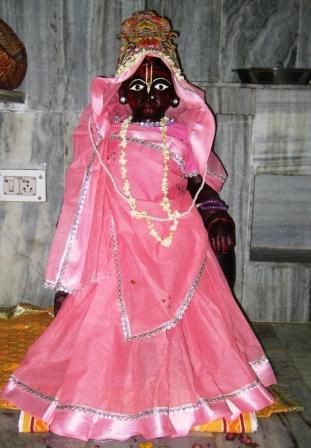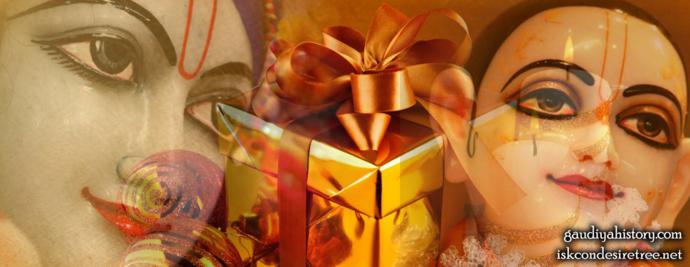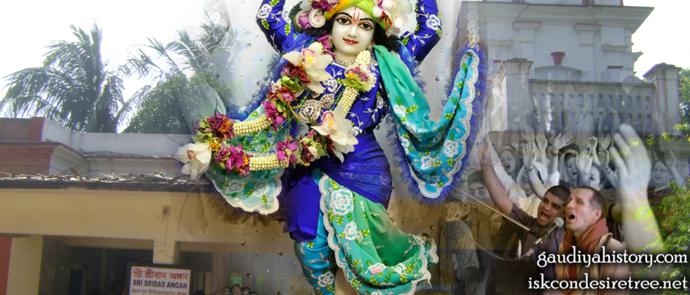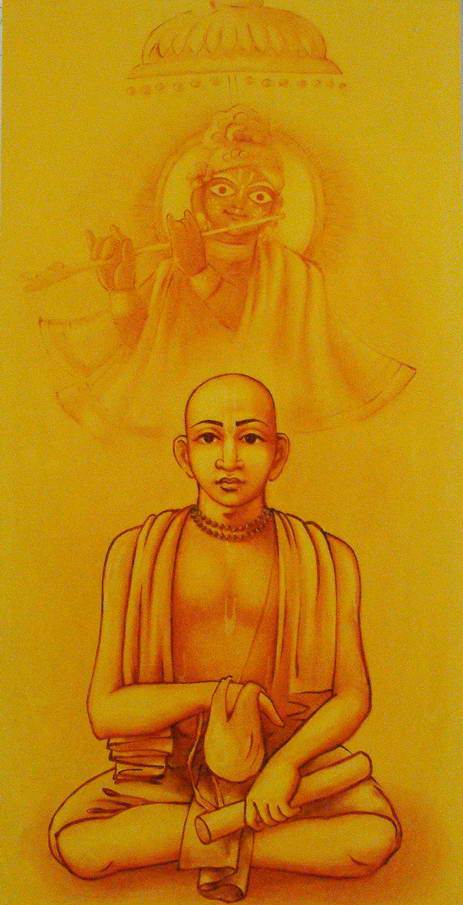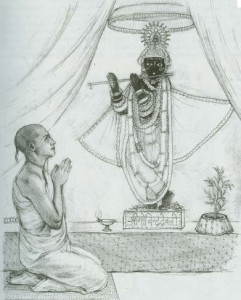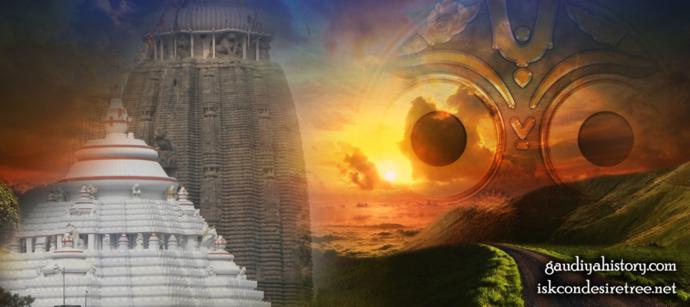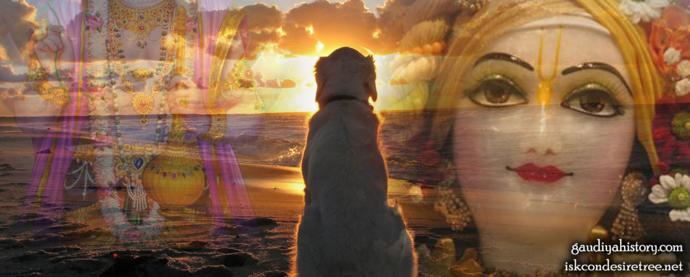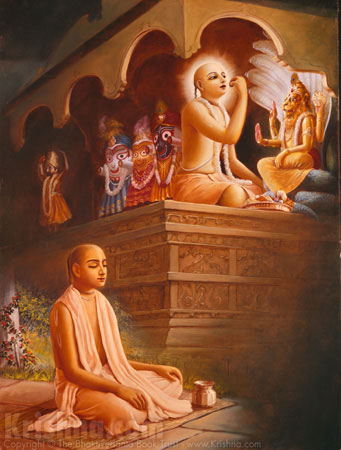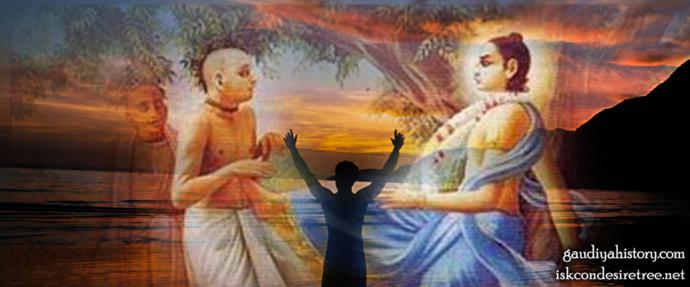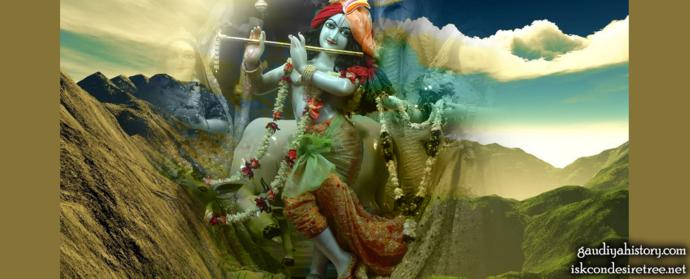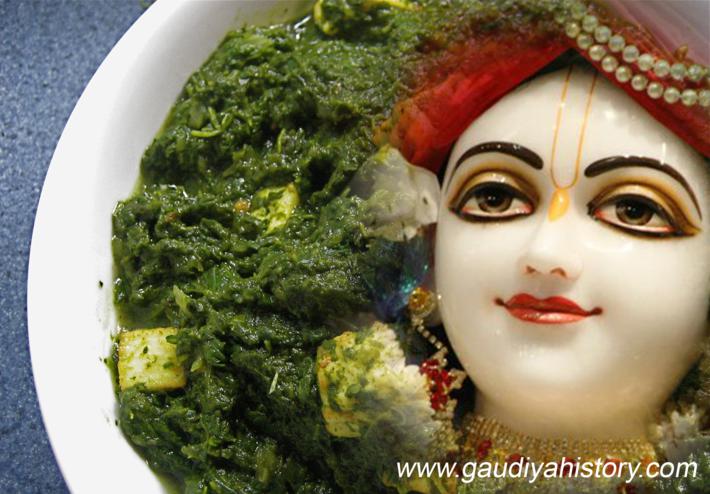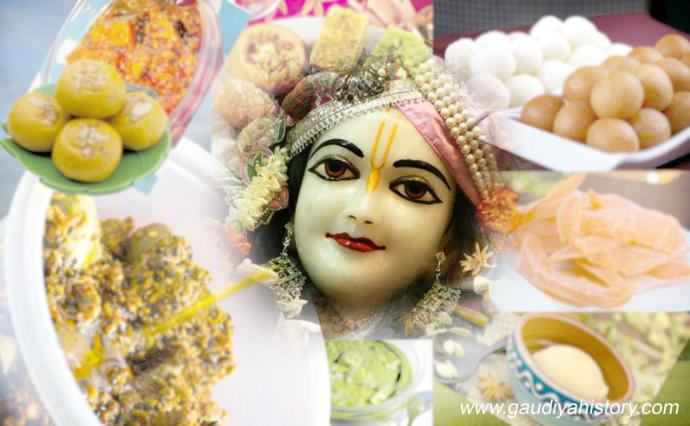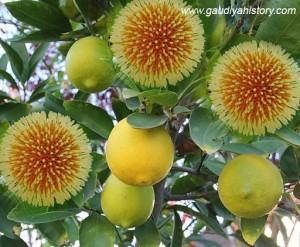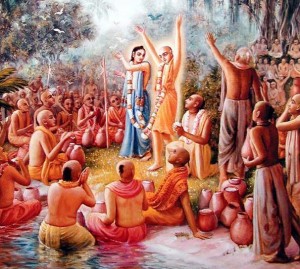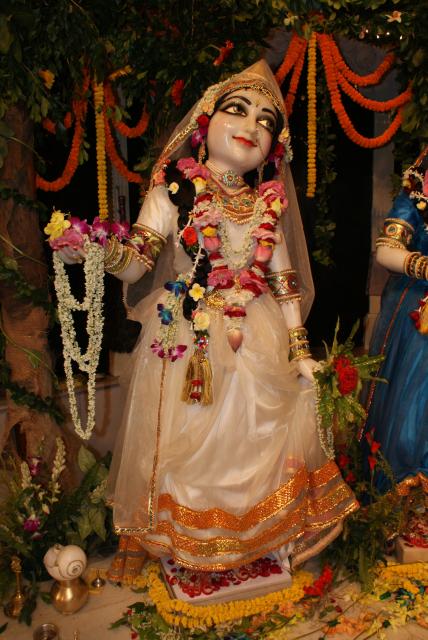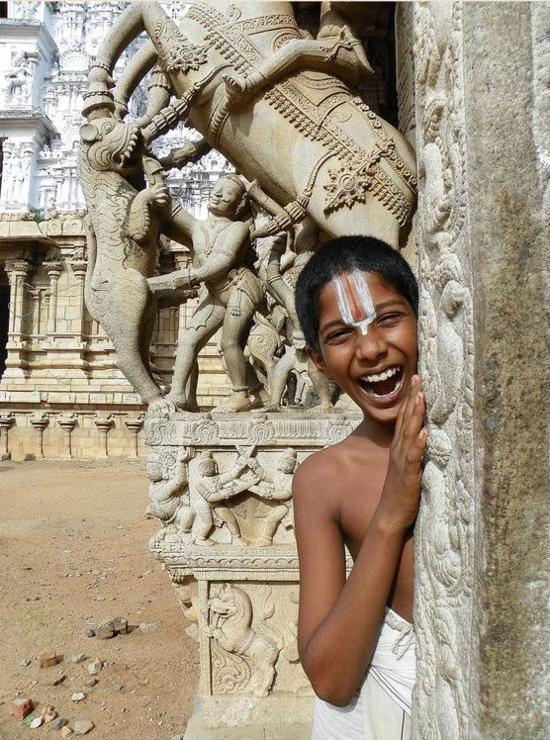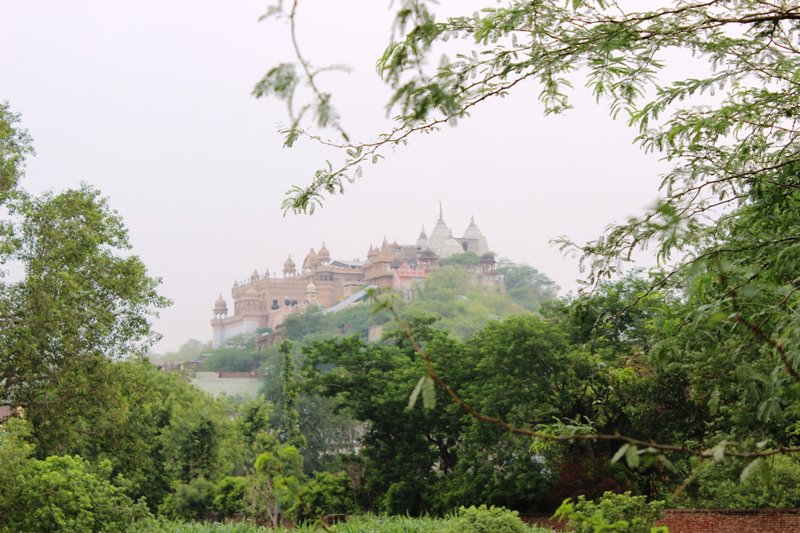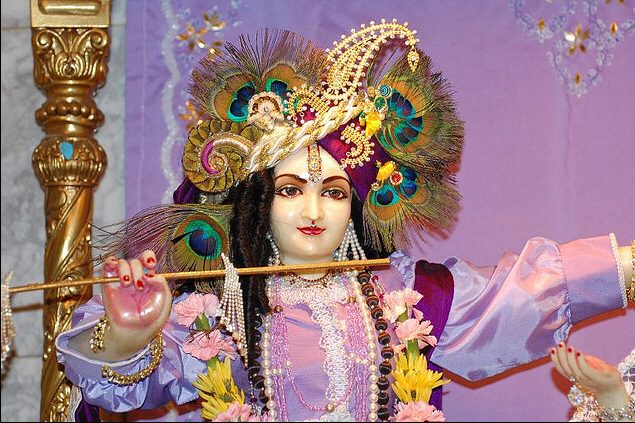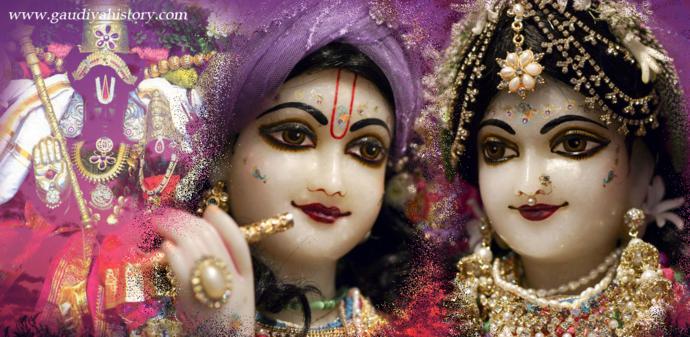Mahaprabhu’s Alter Ego
The Lord accepted Shikhi Mahiti’s sister as one of Radha’s friends. In the entire world, there were only three and a half Devotees who were so worthy. They were Svarupa Damodar Goswami, Ramananda Raya and Shikhi Mahiti. His sister was the half person. (Chaitanya Charitamrita 3.2.105-6)
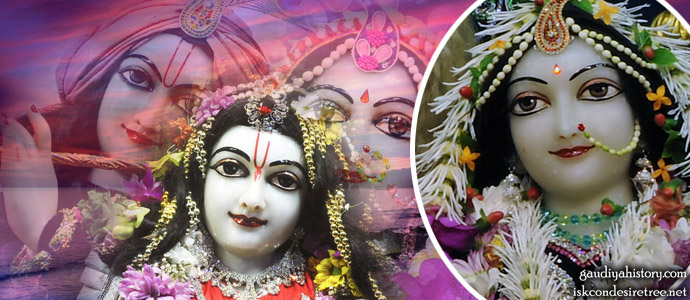
In His lila as the golden avatar, Mahaprabhu is Krishna Himself enveloped by the desire and bodily luster of Shrimati Radharani. Shri Svarupa Damodar Goswami was his alter ego. Because of his intimate connection to the Lord, he was able to know all the most confidential reasons for His incarnation as well as the most secret aspects of His lila. He later divulged these understandings to a larger audience of Devotees. In Vraja-lila, he was also Radharani’s alter-ego, Lalita Sakhi. In the Gaura-ganoddesha-dipika, Kavi Karnapura identifies Shri Svarupa Damodar Goswami as Radha’s other companion, Vishakha Devi. (In the wallpaper: from left to right and to backside Shri Gaurachandra, Shrimati Vishakha Devi, Shri Shri Radha Gopinath, ISKCON Chowpatty, Mumbai).
Shri Svarupa Damodar Goswami was one of Mahaprabhu’s three and a half most intimate associates. Elsewhere Krishnadas Kaviraj Goswami has called him the most important of the Lord’s companions. Two persons knew the Lord best: Paramananda Puri and Svarupa Damodar. (Chaitanya Charitamrita 1.10.124-5)
I have already shown that preaching the sankirtan movement was the external cause for the Lord’s descent. There is another, primary purpose for the Lord’s incarnation. This is the personal work of Krishna, the foremost enjoyer of loving exchanges. This very confidential cause is three-fold, as has been revealed by Svarupa Damodar Goswami. Shri Svarupa Damodar Goswami was extremely close to the Lord and thus was able to know all these matters. (Chaitanya Charitamrita 1.4.103-5)
In His lila as the golden avatar, Mahaprabhu is Krishna Himself enveloped by the desire and bodily luster of Shrimati Radharani. Shri Svarupa Damodar Goswami was his alter ego. Because of his intimate connection to the Lord, he was able to know all the most confidential reasons for His incarnation as well as the most secret aspects of His lila. He later divulged these understandings to a larger audience of Devotees. In Vraja-lila, he was also Radharani’s alter-ego, Lalita Sakhi. In the Gaura-ganoddesha-dipika, Kavi Karnapura identifies Shri Svarupa Damodar Goswami as Radha’s other companion, Vishakha Devi.
kalam ashikshayad radham ya vishakha vraje pura
sadya Svarupa-gosvami tat-tad-bhava-vilasavan
That same Vishakha who previously taught Radha the arts in Vraja is today Svarupa Goswami, who rejoices in the moods of Radha and Krishna.
In the last twelve years of the his pastimes in Puri, the Lord remained constantly absorbed in the mood of Radharani. During this time, only Svarupa Damodar and Ramananda Raya were able to experience the depths of His emotion through relishing topics known only to them.
candidasa vidyapati rayera nataka giti
karnamrita shri gita-govinda
svarupa ramananda sane mahaprabhu ratri-dine
gaya, shune parama ananda
Day and night, Mahaprabhu ecstatically relished the songs of Chandi Das, Vidyapati and Ramananda Raya’s plays, as well as Krishna-Karnamrita and Gita-Govinda in the company of Svarupa and Ramananda. (Chaitanya Charitamrita 2.2.77)
Paramananda Puri had parental affection for Mahaprabhu; Ramananda Raya had love for Him in pure friendship; Govinda Das’s love for Him was as a servant. Gadadhara, Jagadananda and Svarupa Damodar worshiped Him in the ecstasy of the chief rasa. Mahaprabhu heart was won by these four different loving attitudes. (Chaitanya Charitamrita 2.2.78)
Shrila Bhaktisiddhanta Saraswati Goswami Thakur has explained these verses in his Anubhashya as follows: Shri Paramananda Puri, who was Uddhava in Krishna-lila, loved Mahaprabhu with parental affection; Ramananda, who was either Vishakha or Arjuna, had the pure sentiment of a close friend; Govinda and others were devoted to their service to the Lord, and possessed a pure mood of service (shuddha-dasya). Gadadhara, Jagadananda and Svarupa Damodar served the Lord in the primary sentiment, i.e., that of erotic love (madhura-rasa). The Lord became obliged to these Devotees, accepting their worship, their association, their service and their joy.
Svarupa Damodar’s Kariacha
Murari Gupta explained all of the Lord’s early pastimes in the form of an outline. Svarupa Damodar did the same for the Lord’s later pastimes. The Devotees describe the Lord’s activities by following the order given in these two outlines. (Chaitanya Charitamrita 1.13.15-17)
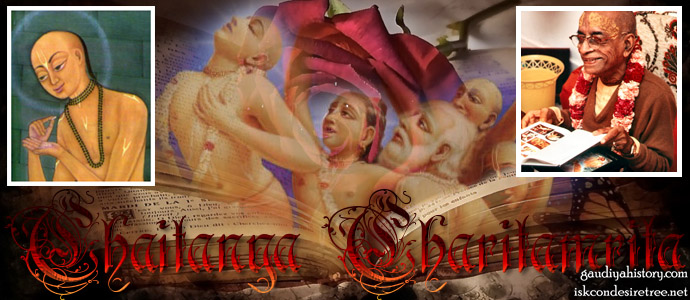
Chaitanya-lila is like the finest of jewels which were held in Shri Svarupa Damodar Goswami’s storehouse and then placed by him around Raghunath Das’s neck. I have written down here whatever I heard from him as extensively as I was able, making a gift of it to the Devotees. (Chaitanya Charitamrita 2.2.85) (In the wallpaper: from left to right and backside Shrila Raghunatha Das Goswami Maharaja, Srila Prabhupada, Pancha Tattva members on the book).
Shrila Bhaktivinoda Thakur has written his commentary on these verses: Murari Gupta’s outline of the Lord’s early pastimes are still extant, so Devotees were able to expand on the Lord’s pastimes after looking at his written text. The Vaishnavas only heard Svarupa Damodar’s kariacha through Raghunath Das Goswami.
Chaitanya-lila is like the finest of jewels which were held in Shri Svarupa Damodar Goswami’s storehouse and then placed by him around Raghunath Das’s neck. I have written down here whatever I heard from him as extensively as I was able, making a gift of it to the Devotees. (Chaitanya Charitamrita 2.2.85)
Shrila Bhaktivinoda Thakur comments on this verse in his Amrita-pravaha-bhashya as follows: Svarupa Damodar described the Lord’s latter pastimes in summary Sanskrit verses known as a kariacha. He made Raghunath Das memorize these verses, and later Krishnadas Kaviraj Goswami spread these accounts of the Lord’s activities throughout the world. As a result, Svarupa Damodar’s kariacha was never published in book form. The Chaitanya Charitamrita is itself the essence of Shri Svarupa Damodar Goswami’s kariacha.
Svarupa Damodar’s Kirtan
Shri Svarupa Damodar used to used to make Mahaprabhu very happy by singing the songs of Vidyapati, Chandi Das and Gita Govinda. He was as expert a musician as the Gandharvas, and in knowledge of the scripure he was just like Brihaspati. No personality was his equal. Shri Svarupa Damodar was also very dear to Advaita acharya and Nityananda Prabhu, and he was the life and soul of all the Devotees, headed by Shrivasa Thakur. (Chaitanya Charitamrita 2.10.115-7)
Krishnadas Kaviraj Goswami has described the extent to which Shri Svarupa Damodar Goswami and Ramananda Raya were dear to Mahaprabhu in the 15th chapter of the Antya-lila:
After saying these things, the Lord took Svarupa Damodar and Ramananda Raya by the shoulders and said, “Listen, Svarupa and Rama Raya! Tell Me what I should do, where should I go in order to find Krishna. You can tell Me the best thing to do.” In this way, Gauranga would tell His tale of woe to Svarupa and Ramananda and they would console Him in His grief. Svarupa would sing and Ramananda would recite Sanskrit verses, giving joy to the Lord with Karnamrita, Vidyapati and Gita-Govinda. (Chaitanya Charitamrita 3.15.24-7)
A similar passage is found in the 20th chapter of the Antya-lila.
Mahaprabhu remained in Nilachala in this way, passing the days and nights absorbed in the anxiety of separation from Krishna. Svarupa and Ramananda were always with Him, bringing Him ecstasy with their recitation of songs and verses appropriate to His mood. (Chaitanya Charitamrita 3.20.3-4)
Vrindavan Das Thakur has also named Shri Svarupa Damodar Goswami as one of Mahaprabhu’s principal associates in his Chaitanya Bhagavat. He describes there how the Lord would lose external consciousness when hearing Svarupa’s kirtan:
Whenever Svarupa Damodar would sing aloud, the Lord would lose all awareness of His surroundings and fall to the ground. Of all the sannyasis who were members of the Lord’s entourage, none was the equal of Shri Svarupa Damodar Goswami. The Lord had a great deal of affection for Paramananda Puri, and an equal amount for Svarupa Damodar. Svarupa Damodar was full of the nectar of devotional songs, which would make the Lord dance as soon as He heard them. (Chaitanya Bhagavat 3.10.40-3)
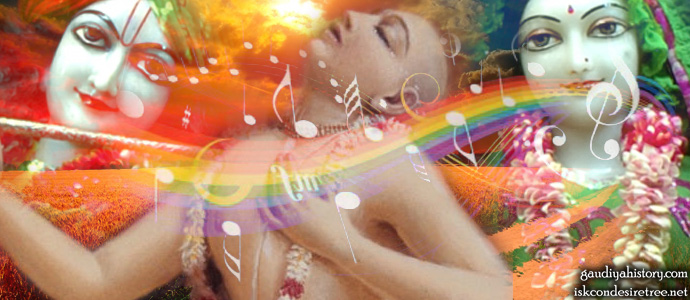
Whenever Svarupa Damodar would sing aloud, the Lord would lose all awareness of His surroundings and fall to the ground. Of all the sannyasis who were members of the Lord’s entourage, none was the equal of Shri Svarupa Damodar Goswami. The Lord had a great deal of affection for Paramananda Puri, and an equal amount for Svarupa Damodar. Svarupa Damodar was full of the nectar of devotional songs, which would make the Lord dance as soon as He heard them. (Chaitanya Bhagavat 3.10.40-3) (In the wallpaper: in the left Shri Gopinath, in the right Shrimati Vishakha Devi, ISKCON Chowpatty, Mumbai, Lord Shri Krishna Chaitanya).
When Shrila Gadadhara Pandit Goswami was living at Tota Gopinath’s Temple, he would give discourses on the Bhagavat while in an ecstatic trance. He primarily spoke on the sections dealing with the lives of Prahlad and Dhruva. Mahaprabhu was overcome by the eight ecstatic symptoms upon hearing Gadadhara’s Bhagavat readings and Svarupa Damodar’s kirtan.
Gadadhar Pandit was the main expert in the Bhagavat and Svarupa Damodar in kirtan. Svarupa Damodar would sing alone and Mahaprabhu would lose Himself in dance. Mahaprabhu would reveal all the symptoms of ecstatic love such as tears, trembling, laughing, fainting, horripilation and roaring. They all manifested on His body as He danced with the Devotees. When He heard Svarupa Damodar singing the kirtan aloud, the Lord would lose external consciousness and would fall down on the spot. There was no equal to Svarupa amongst all of the Lord’s sannyasi associates. Svarupa was as dear to Him as Paramananda Puri. Shri Svarupa Damodar Goswami was the incarnation of the delight of song, which would make Mahaprabhu dance. (Chaitanya Bhagavat 3.10.36-43)
Early Life and Sannyas
We have the following information about Shri Svarupa Damodar Goswami in terms of his bodily identity. Before taking sannyas, he was known as Purushottam Acharya or Purushottam Bhattacharya. Gaudiya Vaishnava Abhidhana gives the following account of his antecedents: His father’s name was Padmagarbhacharya, the son of Jayarama Chakravarti. His residence was in the village of Bhitadiya on the banks of the Brahmaputra River in Bangla Desh. Jayarama Chakravarti made his home in Navadwip. After his marriage to Jayarama’s daughter, Padmagarbha also came to live there. At the birth of Purushottam, Padmagarbha left his wife and child at his father-in-law’s house and left for Mithila and Kashi in order to study the scriptures. Thus Purushottam Acharya was raised in his maternal grandparents’ home in Navadwip.
Later, when Mahaprabhu took sannyas, he was unable to remain in Navadwip due to the feelings of separation from the Lord and he departed for Benares where he also took the renounced order of life. This is described as follows in the Prema-vilasa:
Purushottam became a resident of Navadwip, staying with his mother’s parents. Filled with all virtues, he became Mahaprabhu’s dear Devotee. When the Lord took sannyas, he went mad with separation and left for Benares where he also took sannyas. Svarupa Damodar was given to him as his sannyas name. He was an intimate Devotee of the Lord, an ocean of rasa.
Krishnadas Kaviraj Goswami has also pointed out some of the special characteristics of Shri Svarupa Damodar Goswami’s sannyas:
On another day, Svarupa Damodar arrived; he was a very intimate friend of the Lord and an ocean of transcendental mellows. Before taking sannyas, he had resided at Navadwip in Mahaprabhu’s association and was known as Purushottam Acharya. When he saw Mahaprabhu accept the renounced order, he became like a madman and immediately went to Varanasi to take sannyas. His sannyas guru, Chaitanyananda Bharati, ordered him to study the Vedanta-sutra and to teach it to others. Svarupa Damodar was a great renunciate as well as a great learned scholar. With heart and soul he took shelter of Krishna’s pastimes.
Due to his enthusiasm to worship Shri Krishna without any disturbance, he accepted the sannyas order almost in madness. When taking sannyas, Purushottam Acharya followed the regulative principles by giving up his tuft of hair and sacred thread, but he did not accept the saffron colored dress. Nor did he take a sannyasi title but rather kept the brahmachari name Svarupa.
Svarupa Damodar then took permission from his sannyas-guru and went to Nilachala where day and night he enjoyed the ecstacies of love for Krishna. Though he had attained the peak of learning, he spoke to no one but remained incognito and in seclusion. (Chaitanya Charitamrita 2.10.102-114)
Shrila Bhaktisiddhanta Saraswati Goswami Thakur has made the following comments on this section of the Chaitanya Charitamrita: In the Dashanami sect founded by Sankaracharya, the lines which take the sannyas names of Tirtha and Ashrama follow the custom of giving the title Brahmachari to anyone who desires to be initiated in the renounced order. The aspirant is then required to vow to remain celibate for the rest of his life. He is also given a brahmachari title, which in Purushottam Acharya’s case was Svarupa Damodara. Upon taking the saffron cloth known as yoga-patta, any brahmachari who has the title Svarupa takes the sannyas name of Tirtha. (Anubhashya, 2.10.102)
In the Dashanami sect, certain regulative principles must be followed before taking sannyas: one must perform eight kinds of shraddha, offering oblations to one's forefathers, the Viraja sacrifice. Then one cuts off the tuft of hair called a shikha and gives up the sacred thread. Svarupa Damodar accepted these preliminary processes in the acceptance of sannyas, but not accept the gurvahvana, saffron cloth, a sannyas title or a danda, and for this reason he retained his brahmachari name.
It may be pointed out here that for those who follow the formalities of tridandi sannyas, the keeping of the shikha, the sacred thread and saffron cloth are approved by the Skanda Purana, which states:
shikhi yajïopaviti syat tridandi sa-kamandaluh
sa pavitrash ca kashayi gayatrim ca japet sada
Wearing the shikha, sacred thread and saffron cloth and carrying the kamandalu water pot, a tridandi sannyasi should constantly chant the gayatri mantra while remaining pure in his habits. Shrila Bhaktivinoda Thakur has also commented in his Amrita-pravaha-bhashya: Purushottam Acharya took Mahaprabhu’s example and took sannyas simply by renouncing his shikha and sutra. His sannyas name was Svarupa Damodar. He did not accept the formality of the yoga-patta because he wished to avoid any danger of becoming falsely proud of his status which would come with taking sannyas. He only wished to worship Krishna without any worries. (to 2.10.108)
In the Anubhashya commentary to Adi-lila (4.105) of Chaitanya Charitamrita, Shrila Bhaktisiddhanta Saraswati Goswami Thakur writes, Purushottam Bhattacharya was a resident of Navadwip. Even prior to Mahaprabhu’s taking sannyas, he desired to renounce the world. He left home and went to Benares, where he accepted the position of brahmacarya in a group of Dashanami sannyasis. When he became a brahmachari, he was given the name Damodar Svarupa. He did not bother completing the sannyas rituals and came to Nilachala, Jagannath Puri, where spent the rest of his life at the Lord’s lotus feet. He became Mahaprabhu’s constant companion, enhancing the Lord’s pleasure by singing the songs requested by the Lord. Svarupa Damodar could understand Mahaprabhu’s secret mission and it was by his grace alone that all the Lord’s Devotees could know His deepest purpose.
Svarupa Arrives in Puri
Mahaprabhu took sannyas on the full moon day of the month of Magh and left for Nilachala in the following month of Phalguna. After delivering Sarvabhauma Bhattacharya, He left for His pilgrimage to South India in the month of Vaishakh. Nityananda Prabhu gave Him a Brahmin named Kala Krishna Das as His servant to accompany Him on this trip. When Mahaprabhu returned from this journey, after having brought good fortune to the inhabitants of the South by bringing them Krishna-prema, Nityananda sent Krishna Das back to Navadwip to inform the Devotees that the Lord had arrived in Puri. The news brought great joy to Sachi Mata, Advaita Acharya, Shrivasa Pandit and the other Devotees. They immediately started making preparations to visit the Lord in Puri. Paramananda Puri had been staying at Sachi Mata’s house and he decided to leave ahead of the others with a Brahmin named Kamala Kanta. They were thus the first to come from Bengal to meet the Lord. Not long afterward, Purushottam Acharya, who had already been to Benares and taken sannyas from Chaitanyananda Bharati and received the name Svarupa Damodar, arrived and joyously entered the Lord’s entourage. When he first saw the Lord, Shri Svarupa Damodar Goswami recited the following prayer:
heloddhulita-khedaya vishadaya pronmilad-amodaya
shamyac-chastra-vivadaya rasa-daya cittarpitonmadaya
shashvad-bhakti-vinodaya sa-madaya madhurya-maryadaya
shri-caitanya daya-nidhe tava daya bhuyad amandodaya
O ocean of mercy, Shri Chaitanya Mahaprabhu!
May Your auspicious mercy arise like the dawn
driving away all kinds of material lamentation,
making everything pure and awakening transcendental bliss,
ending all quarrels and disagreements among different scriptures,
giving the taste of spiritual life
and maddening the minds of those surrendered to you,
constantly giving the intoxicating joy of devotional service,
and revealing the extent of the conjugal mood’s sweetness.
(Chaitanya Charitamrita 2.10.119, Chaitanya-candrodaya nataka 10.8)
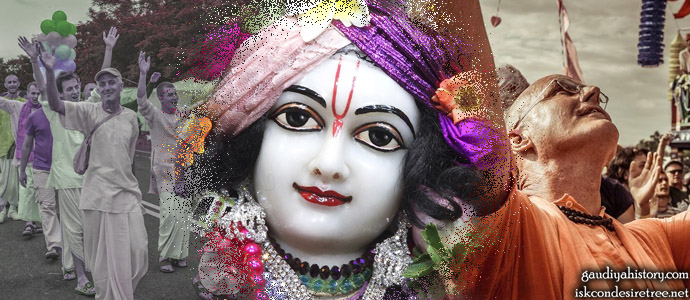
O ocean of mercy, Shri Chaitanya Mahaprabhu! May Your auspicious mercy arise like the dawn driving away all kinds of material lamentation, making everything pure and awakening transcendental bliss, ending all quarrels and disagreements among different scriptures, giving the taste of spiritual life and maddening the minds of those surrendered to you, constantly giving the intoxicating joy of devotional service, and revealing the extent of the conjugal mood’s sweetness. (In the wallpaper: Sankirtan party in Europe, Lord Shri Gaurachandra, ISKCON Chowpatty, Mumbai).
Shri Svarupa Damodar Goswami first received the mercy of the Lord in the form of a heartfelt embrace. Then he paid his obeisances to Nityananda Prabhu and Paramananda Puri and then was introduced to Jagadananda and the other Devotees. He first met Raya Ramananda when the latter came to Puri with King Prataparudra and met Mahaprabhu there for the first time with the intention of persuading the Lord to meet with the king.
Friendship with Pundarika Vidyanidhi
In Puri, Shri Svarupa Damodar Goswami participated in the water sports in Narendra Sarovara at the time of the Chandana yatra and in the Indradyumna Sarovara after the cleaning of the Gundicha Temple. He and Pundarika Vidyanidhi enjoyed splashing each other.
The two friends, Vidyanidhi and Svarupa Damodar, joyously splashed each other and laughed. (Chaitanya Charitamrita 3.8.124)
Jagannath has an an annual festival in Puri named Oriana Shashthi. On this occasion, Jagannath’s pujaris dress the Deity in cloth which still has the tapioca-based starch (mari) in it. Shri Pundarika Vidyanidhi did not like this behavior of the pujaris, as he considered such cloth to be unclean. He went to Svarupa Damodar and asked him for his opinion on the matter. Svarupa Damodar said to him, the Lord is completely independent. He is not dependent on the rules regulating Deity worship found in the smritis.
Vidyanidhi immediately answered him, “I accept that Jagannath is completely independent. That does not mean that the pujaris are completely independent of the rules and regulations of scripture. They are not brahma, that they dress the Lord in unwashed cloth. Didn’t you know that if you even touch cloth that has mari in it, you are supposed to wash your hands?”
That night Jagannath and Balaram appeared to Shri Pundarika Vidyanidhi in a dream and slapped him on his cheeks for having criticized their sevayatas. By so doing, Jagannath showed that one is not to criticize His servants for apparent lapses in behavior. The smartas are especially subject to criticizing Vaishnava behavior for failing to adhere to the obscure standards of the smriti. Shri Pundarika Vidyanidhi, though his cheeks were swollen from the slaps, was overjoyed to have been touched by their Lordships. Svarupa Damodar also congratulated Vidyanidhi for his good fortune:
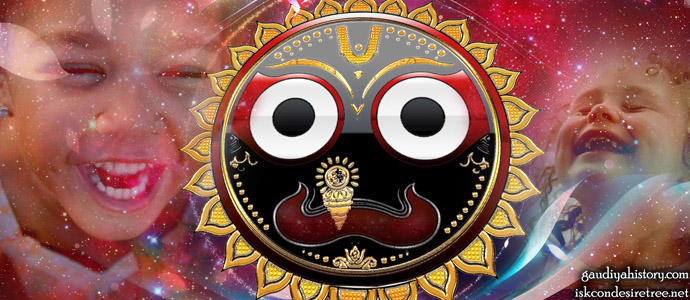
“Listen, brother. I have never seen or heard of a punishment like this one. The Lord came personally to chastise you in a dream. I never heard of such a thing, but now I see that it has happened to you!” The two friends floated in a feeling of satisfaction. They spent day and night talking of nothing but Krishna conscious topics. (Chaitanya Bhagavat 3.10.173-177) (In the wallpaper: Lord Shri Jagannath, laughing kids).
As he looked Pundarika Vidyanidhi over, Svarupa Damodar felt an affection arising in him. Indeed he started to float in an ocean of ecstasy. A friend always feels joy at the good fortune of a friend. The two of them began to laugh spiritedly and Svarupa Damodar said, “Listen, brother. I have never seen or heard of a punishment like this one. The Lord came personally to chastise you in a dream. I never heard of such a thing, but now I see that it has happened to you!” The two friends floated in a feeling of satisfaction. They spent day and night talking of nothing but Krishna conscious topics. (Chaitanya Bhagavat 3.10.173-177)
Gundicha and Rathayatra Pastimes
Shri Svarupa Damodar Goswami was one of the chief participants in the cleaning of the Gundicha Temple on the eve of the Rathayatra. “Other than Nityananda, Advaita, Svarupa, Brahmananda Bharati and Paramananda Puri, everyone carried buckets of water.” (Chaitanya Charitamrita 2.12.109)
During the washing of the Gundicha Temple, a simple but intelligent Brahmin who was not aware of the nature of the Vaishnavas’ devotional etiquette, took some water, suddenly poured it over the Lord’s feet and drank it. In view of Mahaprabhu’s identity as the incarnation of Krishna, it was certainly no offense to drink the water which had washed Mahaprabhu’s feet even though it was done inside the Temple of the Lord, but here Mahaprabhu acted as an exemplar for the world and showed dissatisfaction at the Brahmin’s behavior in order that no other person imitate Him and become an offender to the feet of the Supreme Lord. He let His anger be known to Svarupa Damodar who caught the Bengali Brahmin and pushed him out of the Temple. The next instant, however, he returned to the Lord’s side and asked Him to forgive the Brahmin. Though a Vaishnava may externally appear to be hard-hearted, internally he or she is always filled with compassion and thinks of the welfare of every living being.
Every year during Balaram, Jagannath and Subhadra’s ratha festival, the Lord would make four kirtan groups with His Devotees. Svarupa Damodar would sing in the first of these, with Advaita participating as the principal dancer. With other kirtan groups from Shantipur, Shri Khanda and Kulina Grama, there were seven sampradayas altogether. In each group, there were two drummers, meaning that there were 14sadya Svarupa-gosvami tat-tad-bhava-vilasavannbsp; altogether. When the kirtan started in each nbsp; of the seven groups, Mahaprabhu demonstrated His divine powers by appearing simultaneously in the midst of each one of them. Shrila Bhaktivinoda Thakur writes, “Just as the Lord expands into numerous forms during the rasa dance and to marry the queens in Dvaraka, Lord Chaitanya expanded in order to be present in the midst of each sampradayas’ kirtan. The members of each group were convinced that the Lord was in his group alone and in none of the others.”
When Mahaprabhu wished to dance madly, He would have the seven groups come together and would dance in their midst, appointing nine singers and making Svarupa Damodar the principal singer. As the Devotees became progressively intoxicated by the kirtan, Mahaprabhu danced frenziedly for many moments. After this, Mahaprabhu’s mood changed. Svarupa Damodar was able to understand the Lord’s intention and began to sing,
sei to parananatha painu
jaha lagi madana-dahane jhuri genu
”I have finally found my life’s lord, for whom I had so long burned in the flames of desire.”
Bhaktivinoda Thakur writes, “As the Lord’s frenzied dancing came to an end, He became absorbed in the mood of Radharani at Kurukshetra. This song about meeting the beloved after a long separation came naturally to Svarupa Damodar’s lips.” As He felt the mood of union strengthening, the Lord began to loudly recite the following verse:
yah kaumaraharah sa eva hi varas ta eva caitra-kshapas
te conmilita-malati-surabhayah praudhah kadambanilah
sa caivasmi tathapi tatra surata-vyapara-lila-vidhau
reva-rodhasi vetasi-taru-tale cetah samutkanthate
(Kavya-prakasha 1)
My husband (vara) is the same who took my maidenhead
and these the moondrenched nights we knew;
the very breeze is blowing from the Vindhya hills,
heavy with the scent of newly blossomed jasmine.
I too am still the same;
and yet with all my heart I yearn for the reedbeds by the stream
which knew our happy, graceful,
unending bouts of love.
This verse was written about a mundane lover and his mistress, but Mahaprabhu recited it with great respectful feeling. No one could understand what was His hidden intention other than Svarupa Damodar.
The Lord repeated this verse again and again. No one but Svarupa Damodar could understand His intention. (Chaitanya Charitamrita 2.13.122)
When Rupa Goswami heard the Lord recite this verse, he himself composed a verse which revealed the deeper meaning which the Lord had envisioned. He wrote it down on a palm leaf and hid it in the roof of his cottage. The Lord somehow or other found this palm leaf and when He read it was overcome by prema.
When Mahaprabhu went to the residence of Shrila Rupa Goswami, He accidentally saw the palm leaf on the roof, and thus He read the verse composed by him. After reading the verse, He went into a ecstatic mood. While He was in that state, Shrila Rupa Goswami came and immediately fell down on the floor like a stick.
The Lord got up and gave him a slap. Then, He embraced him and began to speak as follows: “No one knows the purport of My verse. How could you understand My intention?” Saying this, Lord Chaitanya Mahaprabhu bestowed various blessings upon Rupa Goswami, and taking the verse, He later showed it to Svarupa Goswami. With great wonder, the Lord asked him how Rupa Goswami could have understood the intentions of His mind. Shrila Svarupa Damodar Goswami replied, “If Rupa Goswami can understand Your mind, I believe it must be the result of Your special benediction.” (Chaitanya Charitamrita 2.13.66-72)
Rupa Goswami’s verse was the following:
priyah so’yam krishnah sahacari kurukshetra-militas
tathaham sa radha tad idam ubhayoh sangama-sukham
tathapy antah-khelan-madhura-murali-païcama-jushe
mano me kalindi-pulina-vipinaya sprihayati
(Padyavali, 383)
O companion! This is my beloved Krishna
meeting me here in Kurukshetra;
and I am the same Radha,
and both of us are feeling the joy of union.
Even so, my mind wishes for the forest
by the banks of the Yamuna
where the fifth note of His flute
plays sweetly within my heart.
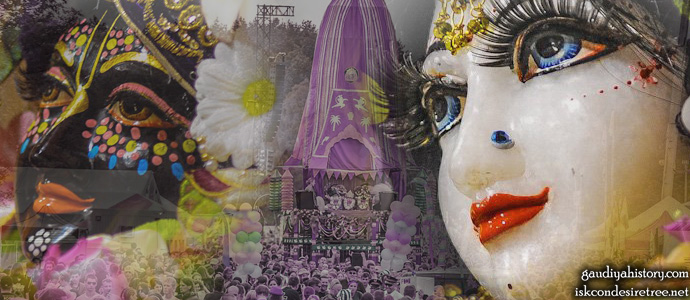
O companion! This is my beloved Krishna meeting me here in Kurukshetra; and I am the same Radha, and both of us are feeling the joy of union. Even so, my mind wishes for the forest by the banks of the Yamuna where the fifth note of His flute plays sweetly within my heart. (In the wallpaper: Jagannatha Ratha Yatra, Woodstock, Shri Shri Radha Krishna).
Mahaprabhu’s vision was that the Jagannath Temple was Kurukshetra and the Gundicha Temple Vrindavan. In the mood of a gopi, He began to pull on Jagannath’s chariot, pulling Him back to Vrindavan. Shri Svarupa Damodar Goswami was able to understand all of these various moods that Mahaprabhu experienced during the Rathayatra.
The Lord had relished these topics in His room with Svarupa Damodar for days and nights. When He was overcome with this mood while dancing before the Lord’s chariot, He would repeat this verse while gazing upon Jagannath’s face. No one can describe Shri Svarupa Damodar Goswami’s good fortune, for he was completely absorbed, body, mind and soul, in the Lord. His senses are the Lord’s senses, and he would sing so that the Lord could more deeply relish the sentiments of love. (Chaitanya Charitamrita 2.13.161-4)
Jagannath Deva lives in Dvaraka and desires to go once a year to Vrindavan. This is symbolized by the Rathayatra festival when He travels from the Jagannath Temple (Dvaraka) to Gundicha (Vrindavana). When He goes to Vrindavan, Jagannath does not take Lakshmi with Him, because Lakshmi is not qualified to participate in the Vrindavan lila. Only the gopis have such qualifications, and Radha is the best of the gopis.
Shvarupa said, “Listen, my Lord, to the reason for this. Lakshmi does not have the right to participate in the games of Vrindavan. Krishna’s companions in the Vrindavan lila are the gopis, and there are none but they who can enchant His mind.” (Chaitanya Charitamrita 2.14.122-3)
Amongst the gopis, Radha is the best. She is a treasure chest of jewels of love in the bright and spotless sentiment of conjugal love. (Chaitanya Charitamrita 2.14.160)
Jagannath mounted His chariot after telling Lakshmi that He would be back on the very next day. When Lakshmi saw that the Lord was late in returning, she became angry and gathering up her forces, sallied forth to attack her beloved. Her servants captured the servants of Lord Jagannath and brought them to her. Such lovers’ quarrels are not heard of anywhere in the world. Nevertheless, the mana (loving jealousy) of the gopis is superior to that of Lakshmi, and of all the gopis, that of Radha is the purest. When Mahaprabhu wished to hear about the gopis’ mana from Svarupa Damodar, Svarupa gave him great satisfaction by answering extensively. He was always able to please the Lord because he knew His wishes so intimately.
Bhagavan Acharya and His Brother
Shri Svarupa Damodar Goswami had a close friendship with the lame Bhagavan Acharya of Halisahar.
Bhagavan Acharya was a great Devotee, a scholar and and a man of refined habits. He came to Purushottam to be with the Lord. He was an incarnation of a cowherd who served Krishna in the mood of friendship. His dealings with Svarupa Damodar were also those of a close friend. He was completely surrendered to the Lord’s lotus feet, and he occasionally invited him to eat at his residence. (Chaitanya Charitamrita 3.2.84-6)
Bhagavan Acharya was a generous and unpretentious Vaishnava. Even so, his father Shatananda Khan was a very materialistic person and his younger brother Gopal Bhattacharya was a mayavadi. When Gopal Bhattacharya came to Puri, the simple, straightforward Bhagavan Acharya asked Svarupa Damodar to listen to his brother speak on Shankara’s Vedanta-bhashya: “Gopal, my younger brother, has come here after finishing his study of Vedanta philosophy. Come everyone and hear the commentary upon Vedanta from him.”
Svarupa Damodar Goswami, however, somewhat angry out of love for Bhagavan Acharya, answered as follows: “You have lost your intelligence in the association of Gopal, and now you are eager to hear the Mayavada philosophy. When a Vaishnava listens to the Shariraka-bhashya, the Mayavada commentary upon Vedanta-sutra, he gives up the attitude that the Lord is the master and the living entity is His servant. Instead, he considers himself to be the Supreme Lord. The Mayavada philosophy is so dangerous that even a highly elevated Devotee who has accepted Krishna as his life and soul changes his attitude when he reads the Mayavada philosophy.”
Bhagavan Acharya continued, “We are all fixed at the lotus feet of Krishna with our hearts and souls. Therefore the Shariraka-bhashya cannot change our minds.”
Svarupa Damodar replied, “Nevertheless, when we hear the Mayavada philosophy, we hear that Brahman is the only spiritual reality and that the universe of maya is false, but we gain no spiritual understanding. When a Devotee hears the Mayavadi say that the living entity is only imaginary and that the Supreme Lord is a manifestation of ignorance, it breaks his heart and life.” (Chaitanya Charitamrita 3.2.92-99)
Svarupa Watches for Rasabhasa
Shvarupa Damodar was the personification of ecstatic love, fully cognizant of the transcendental mellows in relationship with Krishna. He was like a second manifestation of Mahaprabhu. If someone wrote a book or composed verses and songs and wanted to recite them before Shri Chaitanya Mahaprabhu, Svarupa Damodar would have to first examine them before the Lord would agree to listen. Mahaprabhu was never pleased to hear books or verses opposed to siddhanta, nor did He like hearing rasabhasa, an improper mixture of devotional sentiments. It was the practice of Svarupa Damodar Goswami to examine all works of literature to find out whether their conclusions were correct. Only then would he allow them to be heard by the Lord. (Chaitanya Charitamrita 2.10.110-114)
One day a poet came from eastern Bengal who wrote according to his own whim. He had written a play and had read it to Bhagavan Acharya who then asked Svarupa Damodar to give an opinion on it. If Svarupa Damodar approved then it could be presented to Mahaprabhu for His enjoyment. Many of the Vaishnavas had praised the literary qualities of the play, and Svarupa Damodar finally agreed to read it after repeated requests from his friend. But after hearing only the invocation verse, Svarupa Damodar pointed out numerous faults in it, demonstrating how it contradicted Vaishnava dogma. When he saw the poet’s distress at being criticized, Svarupa Damodar became compassionate and said,
jaho bhagavata pario vaishnavera sthane
ekanta ashraya karo caitanya-carane
caitanyera bhakta-ganera nitya karo sanga
tabe to janiba siddhanta-samudra-taranga
(Chaitanya Charitamrita 3.5.131-2)
Go and study the Bhagavat from a Vaishnava. Take exclusive shelter of Chaitanya Mahaprabhu’s lotus feet. Associate constantly with the Devotees of Chaitanya Mahaprabhu. Only then will you be able to understand all the waves of the ocean of Vaishnava philosophy.
It was in Bhagavan Acharya’s house that Chota Hari Das came to beg for fine rice from Madhavi Devi and engaged in conversation with her. As a result of his conversing with a woman, Mahaprabhu ostracized Chota Hari Das. The Lord was as hard as a thunderbolt towards Hari Das, and Shri Svarupa Damodar Goswami made an attempt to intercede, persuading Hari Das to eat after he had undertaken a fast. However, Mahaprabhu remained untouched by Svarupa Damodar’s efforts and a year later, Hari Das went to Prayag and gave up his life.
Svarupa and the Goswamis
When Sanatan Goswami came alone to Puri from Mathura, he caught scabies in the Jharikhanda jungle. In Puri, he stayed in Hari Das Thakur’s cottage where Mahaprabhu came to seem him daily, embracing him despite the pus-filled sores which covered his body. Ashamed at his condition, Sanatan decided to commit suicide, but was prevented from doing so by the all-knowing Lord. During his stay in Puri, Sanatan was introduced to all the Devotees of the Lord including Svarupa Damodar.
Govardhana Majumdar’s son, Raghunath Das tricked his guru and family priest Yadunandana Acharya into giving him permission to leave his home. He walked to Puri in only twelve days where he met Mahaprabhu. Mahaprabhu was extremely merciful to Raghunath and turned him over to Shri Svarupa Damodar Goswami for tutelage. From that day on he was known as Svarupa’s Raghu.
When He saw Raghunath’s thin and dirty body, the Lord felt sympathy for him. He turned to Svarupa Damodar and said, “I am turning this Raghunath over to you. I want you to take care of him as though he were your own son and personal servant. I have three Raghunaths in My entourage. From now on, we will call this one Svarupa’s Raghu.” After He had said these words, the Lord took Raghunath’s hand and placed it in that of Svarupa Damodar. (Chaitanya Charitamrita 3.3.201-4)
Raghunath Das never spoke directly to Mahaprabhu. If he wished to make a submission to the Lord, he made it through either Svarupa Damodar or Govinda. He told Svarupa Damodar repeatedly that he wished to hear Mahaprabhu’s personal instructions on how to practice the spiritual life. After Svarupa passed this request on to the Lord, Mahaprabhu smiled and told Raghunath Das, “I have appointed Svarupa Damodar to be your instructor. You may learn from him about the spiritual practices and their goal. I myself do not know as much as he. Nevertheless, if you have faith in My orders, you may fix your direction from the following words: Do not listen to gossip. Don’t engage in gossip. You should not eat very palatable food, nor should you dress very nicely. Always chant the Holy Name of Lord Krishna without any expectation of honor, and offering all respect to others. Mentally render service to Radha and Krishna in Vrindavan. I have briefly given you My instructions, you will learn about them in detail from Svarupa Damodar. (Chaitanya Charitamrita 3.6.233-8)
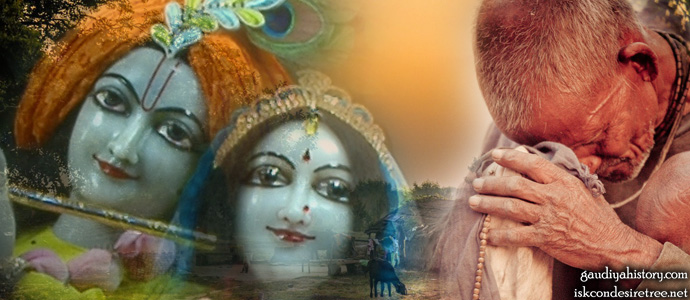
Do not listen to gossip. Don’t engage in gossip. You should not eat very palatable food, nor should you dress very nicely. Always chant the Holy Name of Lord Krishna without any expectation of honor, and offering all respect to others. Mentally render service to Radha and Krishna in Vrindavan. (In the wallpaper: Shri Shri Radha Gopinath, ISKCON Chowpatty, Mumbai, a Devotee).
On the occasion of Hari Das Thakur’s disappearance, the Lord initiated the performance of sankirtan. The Devotees surrounded Hari Das Thakur’s body and Svarupa Damodar sang the Holy Names with the Devotees while Vakresvara Pandit danced. Svarupa Damodar then went to the Jagannath Temple to seek prasad for the feast which followed the burial of Hari Das and he joined Jagadananda Pandit and others to serve the Devotees.
Raghunath Bhatta, the son of Tapana Mishra, left his home in Benares to come to Puri via Bengal. When he met Mahaprabhu, the Lord embraced him and introduced him to Svarupa Damodar and the other Devotees.
Mahaprabhu’s Intense Austerities
At a certain time, Mahaprabhu went through a period of intense austerity. Constantly crying the names of Krishna, He lost a great deal of weight due to His feelings of separation. He slept on a bed of plantain bark, taking no notice of the pain which resulted when His bones rubbed against the bark. The Devotees, however, were greatly distressed to see His suffering. Jagadananda Pandit in particular was affected and he decided to do something about it. He obtained some fine cloth and dyed it saffron, and then filled it with cotton from the silk cotton tree. In this way he made both a mattress and a pillow for the Lord’s comfort. Jagadananda then asked Govinda Das to give the mattress and pillow to the Lord and Svarupa Damodar to convince Him to use them. When it was time for the Lord to go to bed, He saw the nice bed and asked angrily, “Who has made this bed?” When He heard from Govinda that Jagadananda Pandit had given it, He hesitated because Jagadananda was Satyabhama’s incarnation and given to fits of jealous anger. Even so, he had Govinda remove Jagadananda’s bedding and went to sleep on the plantain bark bed. When Svarupa Damodar reminded the Lord that Jagadananda would be distressed if he did not use his bedding, He answered,”A mattress and pillow? Why don’t you just go and get Me a bed? A sannyasi is supposed to sleep on the ground. Jagadananda wants Me to become a sense enjoyer. This is shameful.”
Jagadananda was indeed upset when he heard from Svarupa Damodar that Mahaprabhu had refused the bedding. Svarupa Damodar cleverly made a mattress and pillow out of dried banana leaves torn into small pieces and stuffed into pieces of the Lord’s used clothes. Despite his reluctance, the Lord accepted this new bedding. This satisfied all the Devotees with the exception of Jagadananda, who asked the Lord permission to leave for Vrindavan. Mahaprabhu said, “Jagadananda is angry with Me, that is why he wants to go to Vrindavan.” This story gives a brilliant example of Svarupa Damodar’s expertise in serving the Lord.
Mahaprabhu’s Ecstasies
As Mahaprabhu’s feelings of separation intensified to the point of seeming insanity, He was kept at night in the Gambhira, behind three locked doors. One day, Svarupa and Govinda noticed that even though the doors were still bolted, Mahaprabhu was missing. In great anxiety, the two of them started to look for the Lord everywhere. Finally they found Him near the Lion’s Gate of the Jagannath Temple, lying unconscious on the ground with all His joints loosened, His entire form lengthened. Svarupa Damodar started to sing the names of Krishna into the Lord’s ear until suddenly He jumped up, His body returning to its normal condition, and shouted, “Haribol!” When the Lord returned to normal consciousness, Svarupa Damodar led Him back to the Gambhira.
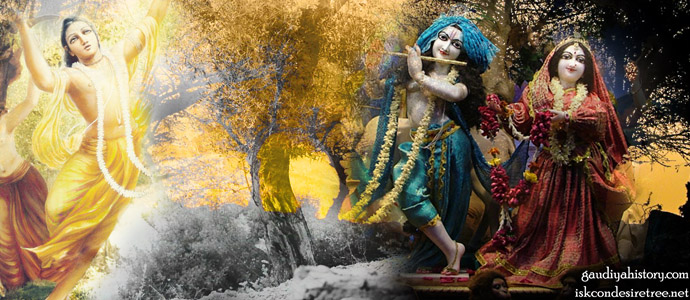
“I was at Govardhana. I saw Krishna herding the cows and playing the flute. When they heard the flute, the gopis came running toward Him. Shrimati Radharani was there and Krishna took here into a grotto. Then suddenly you all started to call Me back here. Why did you do that? Just to bring Me pain?” (In the wallpaper: Shri Shri Radha Gopinath, ISKCON Chowpatty, Mumbai, Lord Chaitanya in the left in Govardhan).
One day, the Lord saw the sand dunes and took them to be Govardhana. He ran towards them, while Svarupa Damodar and Jagadananda ran behind Him. His body was overwhelmed by the ecstatic transformations and He fell to the ground in a faint. When the Devotee’s saw the Lord in this state, they began to cry. He partially regained consciousness when the Devotees started to chant the Holy Name aloud. In this state, He started to prattle, “I was at Govardhana. I saw Krishna herding the cows and playing the flute. When they heard the flute, the gopis came running toward Him. Shrimati Radharani was there and Krishna took here into a grotto. Then suddenly you all started to call Me back here. Why did you do that? Just to bring Me pain?” The Lord began to cry and the Devotees, affected by His great distress at losing His vision, and they joined Him in shedding tears.
A few days later, Mahaprabhu was in the Gambhira in the divyonmada state, the madness of separation. Svarupa Damodar and Ramananda Raya stayed up until the middle of the night with the Lord enjoying discussions of Krishna’s pastimes. Finally, after a great deal of effort, they managed to persuade the Lord to lie down and take some rest, after which they each returned to their own quarters. Govinda also slept in the Gambhira. As he chanted the names of Krishna, Mahaprabhu suddenly heard the sound of Krishna’s flute and in the ecstasy which overcame Him, He ran out of the Gambhira, even though there were three doors bolted from the outside. This time He fell down amongst a herd of Tailangi cows to the south of the Lion’s Gate. When Govinda heard no answer from the Lord, despite calling for Him, he informed Svarupa Damodar of the situation.
Svarupa Damodar organized a search party of Devotees with torches until finally they found Him lying unconscious in the midst of the cows. This time, His limbs were retracted into His body giving it the appearance of a tortoise; His mouth was covered with foam, there were eruptions on His body and His eyes were filled with tears. He looked like a pumpkin, without any limbs. Externally suffering as though poisoned, internally He was experiencing divine ecstasies. The cows had surrounded the Lord and were sniffing His body, and even when the Devotees shooed them away, they would come back, attracted by the Lord. After many attempts to arouse the Lord, when the Devotees failed to bring Him back to consciousness, they picked Him up and carried Him to the Gambhira. There they started singing the Holy Names aloud in kirtan. This continued for some time until finally the Lord returned to an external state of consciousness and His body also took on its normal appearance.
Still in a trance-like state, Mahaprabhu asked Svarupa Damodar, “Where have you brought Me? I had heard the sound of Krishna’s flute and I went to Vrindavan. I saw Krishna with the cattle, playing His flute. Radha and the gopis understood His signal and came to the bower cottage trysting place. I followed them there and felt ecstasy when hearing the sound of their tinkling ornaments and their voices and laughter. You forced Me to come back here and I can no longer hear their humorous conversations, nor the sound of their ornaments and musical instruments.”
Shri Svarupa Damodar Goswami recognized the Lord’s state and sang a verse from the Bhagavat in his sweet voice:
ka stry-anga te kala-padayata-venu-gita-
sammohitarya-caritan na calet trilokyam
trailokya-saubhagam idam ca nirikshya rupam
yad go-dvija-druma-mrigah pulakany abibhrat
O dear one!
What woman within these three worlds
would not be captivated by the sweet rhythms
of your wonderful flute-song?
What woman would not abandon
her vows of chastity as a result?
For upon beholding your beauty,
the most sublime in this universe
even cows, birds, trees and animals
horripilate in jubilation.
(BhP 10.29.40)
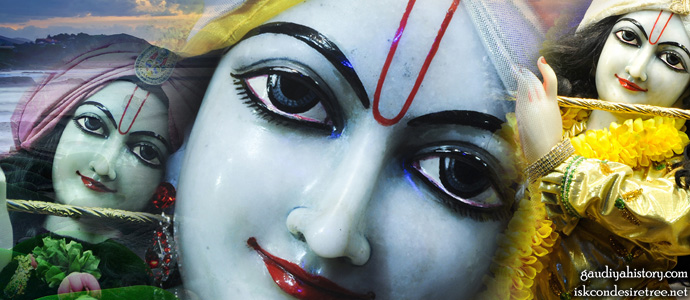
O dear one! What woman within these three worlds would not be captivated by the sweet rhythms of your wonderful flute-song? What woman would not abandon her vows of chastity as a result? For upon beholding your beauty, the most sublime in this universe even cows, birds, trees and animals horripilate in jubilation. (BhP 10.29.40) (In the wallpaper: Shri Gopinath, ISKCON Chowpatty, Mumbai).
As soon as the Lord heard this verse, He once again merged into the mood of the gopis and began to sing all the statements which the gopis made in separation from Krishna, known as chitra-jalpa.
The Lord Jumps into the Sea
Krishnadas Kaviraj Goswami has described another extraordinary event of this type. Once, during a full-moon evening in autumn, the Lord was inspired to remember Krishna’s rasa-lila. Accompanied by His Devotees, He wandered through the Ai Tota garden next to the Gundicha Temple, relishing songs about the rasa dance. As they approached the seashore, Mahaprabhu took the sea to be the Yamuna River and jumped into it. His body floated south toward Konarka until a fisherman caught Him in his nets, thinking Him to be a large fish. When he dragged the Lord on board his boat, he saw that all His limbs were distended, transformed into a giant human form. Upon touching Him, the fisherman was immediately infused with prema and started crying and calling the name of Krishna.
Meanwhile, Svarupa Damodar and the other Devotees were desperately seeking the Lord. Finally they saw the fisherman standing on the shore with the Lord on his shoulders. When Svarupa saw the fisherman in a state of ecstatic transformation, he came and explained who Mahaprabhu was, but still had to slap him several times before he calmed down. Then the Devotees began to sing the Holy Names aloud until the Lord jumped up with a roar. Once again, while in a state of half-absorption in trance, Mahaprabhu recounted everything that He had experienced. Mahaprabhu had been in the world of Krishna’s rasa-lila and water sports. When they heard all His ecstatic utterances, the Devotees trembled in awareness of the Lord’s divine loving madness. Then they led Him back to the Gambhira.
The Lord’s Final Days
When Advaita Acharya sent the riddle message back from Bengal with Jagadananda Pandit, indicating that the Lord’s pastimes would soon come to an end, Svarupa Damodar became distracted, while the Lord’s divine madness became more and more intense. In His final instructions to Svarupa Damodar and Ramananda Raya, the Lord made it very clear that Harinama sankirtan is the supreme method for attaining love for Krishna.
The Lord, in a wave of jubilation say, “Listen Svarupa Damodar and Ramananda Raya! In the age of Kali, Harinama sankirtan is the supreme means of deliverance. In the age of Kali, Krishna is to be worshiped by the congregational chanting of His Holy Names. This is the way that an intelligent person attains the lotus feet of Krishna. Through the chanting of the Holy Name, all of one’s sinful reactions are extinguished and all auspiciousness arises until finally one experiences the joys of love for Krishna.” (Chaitanya Charitamrita 3.20.8-11)
After saying this, the Lord recited His own eight verses known as the Shikshashtaka. As He relished them, He felt more and more humble in feelings of separation from Krishna. Taking on the mood of Shrimati Radharani, He became totally absorbed in love for Krishna.
Shri Svarupa Damodar Goswami and Ramananda Raya remained constantly by the Lord’s side throughout His ecstasies in divyonmada, calming Him and enriching His feelings of love. Shri Svarupa Damodar Goswami left the world on the day of Lord Jagannath’s Rathayatra, not long after the Lord’s disappearance.
[Excerpted from “Shri Chaitanya: His Life & Associates” by Shrila Bhakti Ballabh Tirtha Maharaj]
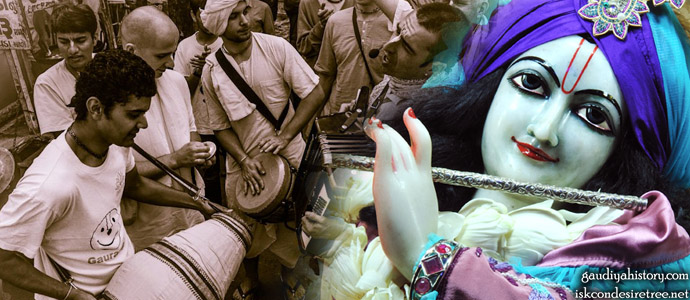
The Lord, in a wave of jubilation say, “Listen Svarupa Damodar and Ramananda Raya! In the age of Kali, Harinama sankirtan is the supreme means of deliverance. In the age of Kali, Krishna is to be worshiped by the congregational chanting of His Holy Names. This is the way that an intelligent person attains the lotus feet of Krishna. Through the chanting of the Holy Name, all of one’s sinful reactions are extinguished and all auspiciousness arises until finally one experiences the joys of love for Krishna.” (Chaitanya Charitamrita 3.20.8-11) (In the wallpaper: in the right Shri Gopinath, ISKCON Chowpatty, Mumbai, Harinama).










